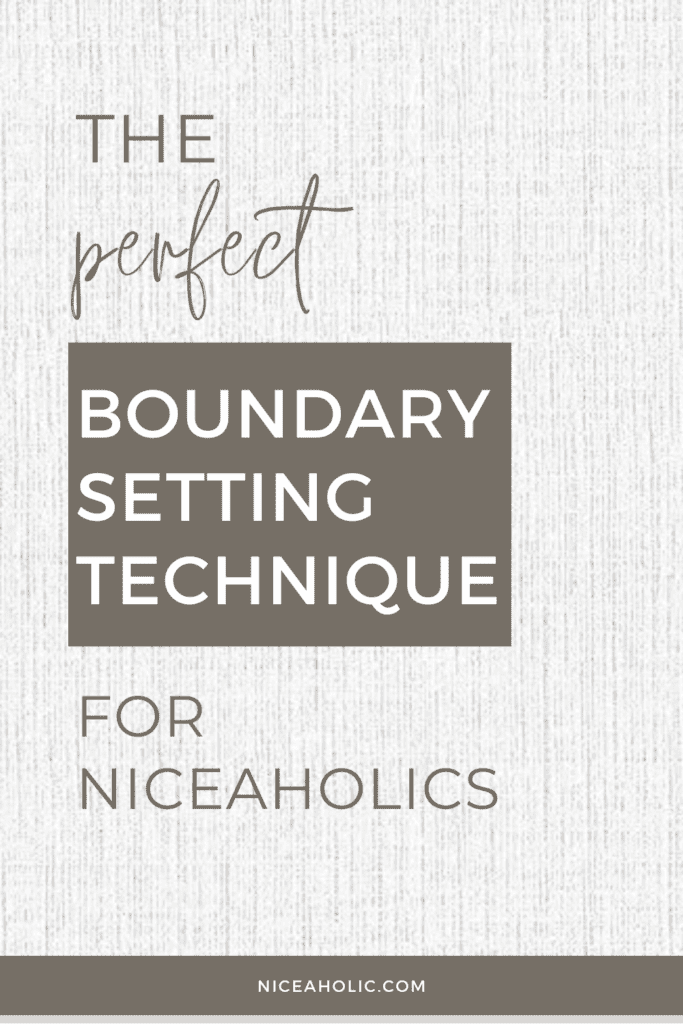The Perfect Boundary Setting Technique for Niceaholics

Every niceaholic struggles with setting boundaries.
We find it incredibly difficult to put our foot down and say no.
And yet the more we cater to difficult people, the more invisible we start to feel.
We get stuck wondering things like, “Why aren’t I assertive enough to say no?” or “How do I even set a boundary?”
When you’re unsure what to do, it’s hard to move forward.
The good news is, you can easily learn to set boundaries, even if you’ve never set one before in your life!
In this post, I’ll define what boundaries are and provide 3 crucial components you need in place, to set successful boundaries as a beginner.
I hope that this will give you a roadmap so you can get started with boundaries and give you the strength to say no and mean it!
What is the perfect boundary-setting technique for niceaholics?
In relationships, according to the Cambridge dictionary, boundaries are “a limit of what someone considers to be acceptable behavior.”
But I always find it more helpful to think of boundaries as an invisible fence that sits between you and others to provide protection from emotional, physical, or mental harm.
In other words: boundaries are to protect you from undesirable behavior and harm.
This means when you have strong boundaries in place, you are less likely to be pushed around or hurt. (Bullies prefer an easier target.)
The added benefit is that you build tons of confidence when you can assert yourself without it being a big deal anymore.
Setting Boundaries Component #1 – Mindset
What does mindset have to do with setting boundaries?
Well, the way you think about boundaries determines how successful you will be.
This is a crucial component because without a strong mindset around boundaries, you:
a) won’t even set them,
b) their boundaries are weak and are easily pushed over, or
c) aren’t confident enough and don’t enforce them when tested.
It’s not selfish to set boundaries
Many people who are new to setting boundaries start out on the right track but then get stuck because deep down they don’t feel setting boundaries is very nice.
They think it’s selfish to say no to people.
And then they wind up being discouraged and giving up because they are trying to behave in a way that is not aligned with their identity (being a nice person).
The key to setting kind boundaries is to get your mindset strong from the beginning.
To get started, think about boundaries as self-care for you and not something you do against others (i.e. to punish them).
It also helps to think of how you are being honest with people and authentic with them as that is aligned with being a kind person, and as a result, is easier to make the change stick.
Setting Boundaries Component #2 – The right words
Knowing what to say is the second component of successful boundary setting as a beginner.
This is important because when you know what to say you are less worried you are going to hurt someone’s feelings or mess up by winging it.
If you’ve spent hours mulling over the situation and going through different scenarios but something still feels off – like you’re not getting results, this is likely the piece that’s missing.
Without this, you can think about the situation for hours and still not set the boundary successfully when it counts.
What can you do?
A really useful strategy for knowing what to say when setting your first boundary is to use a script.
Preparing a script ahead of time is like having a handy template in your pocket, saving you from trying to think of things to say in the moment.
Setting Boundaries – Examples
Examples of boundaries you may like to prepare for your script are:
- “I don’t know if we can make it. Let me check my schedule and I’ll get back to you.”
- “I can’t hear you clearly when you raise your voice. Why don’t we talk about this another time when you have calmed down?”
- “Until you can have a respectful conversation with me, this discussion is over.”
- “When you speak to me like (describe what they do) it makes me feel like (tell them how you feel). Instead, I’d prefer you (tell them how you’d like them to behave).” E.g., Stick to the topic and not call you names.
Practice, Practice, Practice!
In order for this to come out naturally in the heat of battle, you will need to practice.
If you have a partner or children, you will have plenty of opportunities to test these out in a low-risk environment.
Or you could practice on your pets if you have them, “I don’t like it when you scratch the furniture as it makes me feel like you don’t respect my things. Instead, I would prefer you to use your scratching post.”
They can’t respond but maybe that’s best while your learning 🙂. Haha.
Failing that practice with a trusted friend or family member or just by yourself.
Once you have a few scripts under your belt, you can expand your repertoire to cover a wider range of scenarios.
Setting Boundaries Component #3 -Confidence
Confidence is the ability to know you are worth the effort.
Without confidence, you will keep being tugged along by people’s (often unreasonable) requests and won’t have the guts to say no to them.
Once you start to own your right to set boundaries, it’ll really start to bring it all together.
Of course, this won’t happen overnight.
Consider in the meantime doing things to improve your confidence outside of setting boundaries.
The process you can use to improve your confidence is:
- Talk to yourself in a kind and encouraging way.
- Next, make it a habit to focus on your strengths instead of looking at your weaknesses all the time.
- Then, in order to build more confidence, practice self-care and show yourself, you are a person worthy of being treated well.
- If you like to challenge yourself and become super brave, you can take the extra step of taking small-calculated risks to stretch your comfort zone.
Follow this process consistantly and you’ll be well on your way to being confident enough to set boundaries without even thinking about it.
Putting it All Together for Your Perfect Boundary
There you have it! The 3 components of setting your perfect boundary.
It may sound like a lot, but like most things, practice makes perfect. Just focus on keeping your mindset in check, practicing your scripts, and working on your confidence.
This will help you say no and mean it, and more importantly become a lady who is worthy of respect and is confident enough to express her right to be heard.
What’s next? Download 13 Pages of Beautiful Boundaries.
If you need help to get started, my FREE Beautiful Boundaries Planner is everything you need to get started.
It will help you learn how to identify the triggers that create the need for a boundary (& the people who do the triggering 🙂) and includes a handy boundary creator for the 8 most important areas of your life, so you can finally set successful boundaries that stick and get your life back.
Click here to download Beautiful Boundaries Planner now >> Beautiful Boundaries Planner
Until next time, always be kind to yourself lovely.
Love







